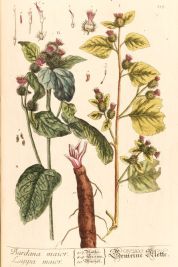Love Leaves: Clingy Burdock
By Audrey Stallsmith

They are burs, I can tell you, they'll stick where they are thrown.
William Shakespeare, Troilus and Cressida
"Love leaves" seems a strange nickname for the pesky burdock. My dog, a high-strung and thin-skinned Border Collie, always looks haunted after tangling with the plant's burrs. She flees, as if in an attempt to outrun the importunate hitchhikers. When I'm attempting to dig them out of her long fur, only to be rewarded with fine spines in my fingertips, I feel less than affectionate toward this particular weed myself!
The "love" may refer to the burdock's vaguely heart-shaped leaves. It could, however, derive from another nickname, philanthropium, which comes from the Greek philantropos-meaning "loving mankind." At first, I assumed this was a tongue-in-cheek reference to the burrs' clingy ways. But after learning of the burdock's many historical uses, I have to concede that it can, indeed, be a friend to man.
The plant has a wealth of such nicknames, including bardana, beggar's buttons, clot-bur, cocklebur, fox's clote, happy major, hardock, personata, and gypsy's or Robin Hood's rhubarb. The Latin name, Arctium lappa, is from the Greek arktos ("bear") in reference to the burr's coarsely hairy texture. Lappa ("to sieze") may derive from the Celtic llap ("hand"). Arctium minus ("lesser burdock") is also common in the U. S., though there is nothing minor about the size of the variety here in PA!
The "bur" in the common name comes from the Latin burra ("lock of wool"), since sheep sometimes leave bits of their coats behind on the cockleburs. Dock is an Old English word for "plant". For obvious reasons burdock stands, in the Language of Flowers, for both "importunity" and "touch me not."
As one of the nicknames indicates, burdock's large leaves are similar to rhubarb's, though less glossy. Burdock's stems have also been eaten, though usually as a vegetable rather than a fruit. Cut before the plant flowers, those stems are stripped of their green rind. Only the white cores are boiled and consumed. They are supposed to taste similar to asparagus and were sometimes candied like angelica.
I always assumed burdock leaves to be as toxic as rhubarb's. Having long experience at trying to wrest burdock's one-to-three-foot roots out of my flowerbeds, I am quite familiar with the plant's less-than-appetizing smell on my hands.
The leaves are supposed to be edible, however, if cooked. Herbalists caution that children under two, pregnant women, and those with acidic stomach problems or ulcers should not consume any part of burdock. Diabetics on insulin should probably avoid it too, since it lowers blood sugar.
The bitter burdock leaves have never proved as popular as the sweeter roots. In Japan those roots, known as gobo, are peeled and boiled like carrots. Pamela Jones describes their flavor as a "blend of celery and potato, with perhaps a soupcon of cucumber." She recommends that any parts of burdock that you plan to eat first be boiled in two changes of water with a pinch of baking soda added. Burdock roots are often an ingredient of sukiyaki.
They are also the dominant ingredient in a gobo gumbo that James Duke recommends for the treatment of HIV. This is only the latest in a long list of ailments for which burdock has been prescribed.
A medieval German abbess named Hildegard of Binger proved to be ahead of her time when she recommended burdock for the treatment of cancer. Harry Hoxsey later picked up on the idea, including burdock among the ten plants in his alternative cancer formula.
Although Hoxsey was often derided-and actually died of prostate cancer himself-most of the plants he espoused have been proved to inhibit tumors. (As modern science has had to admit, we are all so different that no single cancer cure works for everybody.) Burdock contains arctigenin, which not only slows the growth of tumors but also decreases cell mutation.
John Heinerman calls burdock root "the most widely used of all blood purifiers, among the best the herbal kingdom has to offer for this, and the most important herb for treating chronic skin problems." For eruptions such as eczema, burdock can be either consumed--in tea or capsule form--or applied externally.
Burdock is also reputed to have a slightly laxative and diuretic effect, as well as to improve digestion, break up kidney stones, stimulate the liver, cure seborrhea and improve hair growth, and soothe the aches and pains of rheumatism. The plant's large leaves, mashed, were frequently used as a poultice for swellings, bruises, or bug bites. Burdock's most intriguing asset, however, may be its yet unexplained ability to protect lab animals from the effects of toxic chemicals.
If you don't require any of these remedies, you can always toss some of the burrs at the back of a loved one. According to folklore, if the burrs stick that person returns your love--but might change his/her mind if you make a habit of burr-flinging!
As I previously discovered with nettles, it's often the most irritating weeds that do us the most good. I suspect that the same might be true of the most aggravating people. At least it's nice to know that, all the times burdock reached out to grab us, the plant really had something to say!
Arctium lappa image is from Herbarium Blackwellianum by Elisabeth Blackwell, courtesy of the Missouri Botanical Garden.








